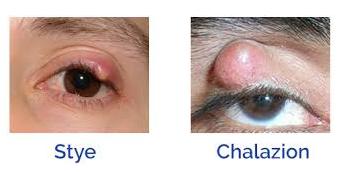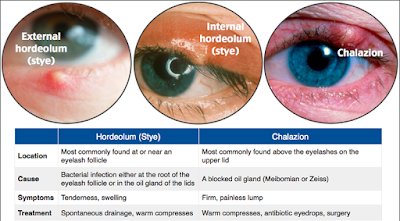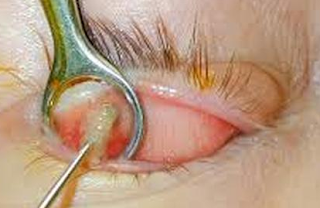A stye (also known as a hordeolum) is blocked Meibomian Gland (MG). The Meibomian Glands produce oil with its orifice near the b ase of an eyelash hair follicle. These oil they excrete should flawlessly mix with the tear film to keep the tear film on the eye for a longer period of time and keep the tear film stable/even to allow for no “dry spots” to appear early after a blink.
ase of an eyelash hair follicle. These oil they excrete should flawlessly mix with the tear film to keep the tear film on the eye for a longer period of time and keep the tear film stable/even to allow for no “dry spots” to appear early after a blink.
Chalazions take longer, and may persist for months without any visible change of scarring, such as redness. Conditions such as recurrent blephartitis (inflammation of the eyelids from Staphloccocus or Demodex), poor li hygiene (not washing your face or using warm compresses every day), poor diet (eating too many carbohydrates and not enough Omega 3/fish oil) can lead to repeated stys or chalazion.


AND
2. Excision of stye or chalazion if above does not help. This is the gold standard for treatment if all else fails. As you can see from the below photo, it is not a fun procedure. It hurts. And if the stye or chalazion is inflammed, the anesthesia does not work as well, and the procedure is quite painful.
When the MG gets blocked by bacteria like Staphylococcus Aureus or mites like Demodex, a mini-abscess forms.
The first symptoms will be mild eye and/or lid pain, then the affected lid becomes red, tender, swollen, and sometimes even warm. If left untreated, styes can lead to preseptal cellulitis where the skin becomes infected and spreads to include a larger part of the eyelid and face. In children and babies this can be very dangerous as the eyelid is close to the brain and can spread to the brain and cause a meningitis, which is thankfully very rare.
A Chalazion is a stye that has been left untreated and has begun to form scar tissue. Chalazions are usually firm or hard. If you have had a “stye” for more than 2-4 weeks, it has likely become a chalazion and becomes harder to get eliminate. You may get more than one stye or chalazion at a time or several in succession.
Symptoms
A sty begins as a small, red bump (nodule) at the base of the eyelash. It progresses into a localized red, swollen and painful bump and may sometimes involve inflammation of the entire eyelid. A small, yellowish spot slowly appears in the center of a sty from which pus eventually drains out. Common symptoms are eyelid tenderness, sensitivity to light and increased tear production.
A chalazion initially appears red and swollen similar to a sty. Eventually it changes to a painless, round mass which grows gradually.
Likely Duration
If you start warm/hot compresses & diluted Tea Tree Oil scrubs, like my video notes below, the stye should go away in a week or less ideally.
Chalazions take longer, and may persist for months without any visible change of scarring, such as redness. Conditions such as recurrent blephartitis (inflammation of the eyelids from Staphloccocus or Demodex), poor li hygiene (not washing your face or using warm compresses every day), poor diet (eating too many carbohydrates and not enough Omega 3/fish oil) can lead to repeated stys or chalazion.
Treatments:
Standard: The Best Treatment for Stye has always been to start the #1 asap: as soon as you feel it coming on! If you catch it late, you would need an excision #2. Now a new option, I believe, is the best way to remove stubborn styes and chalazia: see below.
1. Warm Compresses/hot compresses 100-1000x per day as soon as the stye starts. Use diluted Tea Tree Oil to scrub as noted in video above.


AND
2. Excision of stye or chalazion if above does not help. This is the gold standard for treatment if all else fails. As you can see from the below photo, it is not a fun procedure. It hurts. And if the stye or chalazion is inflammed, the anesthesia does not work as well, and the procedure is quite painful.
The big downside of excision is that once that gland is excised, that gland will not work again to produce oil in most cases. Since we have a limited number of glands, it seems best to save a gland rather than destroy it. Insurance, however, does not cover “gland-saving” procedures and such procedures are expensive.
New: PRP Injection into the Meibomian Gland will likely turn out to be the best way to save a Meibomian Gland from excision.
1. Intraductal probing. I have had success probing an inflammed gland to break through the scar tissue at the orifice and allow the oil to pump through again. There are stubborn chalazia which do not improve with probing, though. This is where I think a new option would help.
2. PRP injection into the Meibomian Gland. I believe this might be the answer to those glands that remain inflamed after probing.
Platelet rich plasma (PRP) is a high concentration of activated platelets obtained from your own blood (that has been spun down in a test tube to isolate a high concentration of platelets). When activated, your platelets release many growth factors that accelerate your body’s natural healing process. PRP also has your own stem cells. If I have another stye or chalazion that does not go away, this is what I would choose for my own eye.
The issue is the cost. PRP costs about $450-550 in our area. Probing of 1 eyelid costs about $500-1000 in our area. This is expensive for a little stye or chalazion. But each Meibomian Gland is priceless. It is not worth the risk of having to spend even more money in the future to save remaining glands or to have chronic eye pain when older. Hopefully in the near future, insurance will pay for “gland saving” procedures as these microscopic glands are essential in not having chronic pain.
Sandra Lora Cremers, MD, FACS
The issue is the cost. PRP costs about $450-550 in our area. Probing of 1 eyelid costs about $500-1000 in our area. This is expensive for a little stye or chalazion. But each Meibomian Gland is priceless. It is not worth the risk of having to spend even more money in the future to save remaining glands or to have chronic eye pain when older. Hopefully in the near future, insurance will pay for “gland saving” procedures as these microscopic glands are essential in not having chronic pain.
Sandra Lora Cremers, MD, FACS




